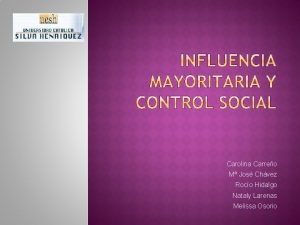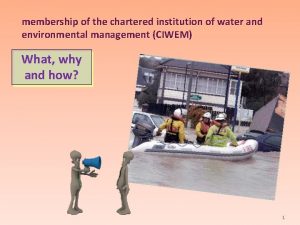Project management Chistyakova Nataly O Project Environment Project










- Slides: 10

Project management Chistyakova Nataly O.

Project Environment Project environment consists of: v The project external environment v The project internal environment

The project external environment ü Political factors: • political stability; • governmental support for the project; • crime rates; • trade balance with participating countries; • participation in military blocks. ü Economic factors: • the structure of national economy; • kinds of liabilities and property rights, particularly the land ownership right; • tariffs and taxes; • insurance guarantees; • inflation rates and currency stability;

The project external environment ü Economic factors: the level of the banking system development; investment sources; the degree of enterprise and economic independence freedom; the level of the market infrastructure development; price rates; the state of the markets of sales, investments, means of production, stock, materials, labor, etc. ü Society – its characteristics and factors: living conditions and living standards; educational level; freedom of movement (entering and leaving a country); labor legislation; health service and medicine, conditions for recreation; public organizations, mass media; the local population’s attitude to the project.

The project external environment The project distant environment ü The system of law: human rights, the rights of entrepreneurship, property rights, laws and normative acts of granting guarantees and privileges. ü Science and Engineering: the level of development of fundamental and applied sciences, the level of information technologies and computerization, the level of production technologies, power systems, transportation systems, communication, utility systems.

The project external environment The project distant environment ü Natural and ecological factors: climate conditions: temperature, precipitation, humidity, winds, altitude above sea level, seismicity, landscape and topography, etc. , natural resources, situation and transport networks links, standards of quality for air space, water sources and soils, sanitary requirements for environment, environmental protection legislation, a characteristic of the ecological system state and its development tendencies. ü Culture: literacy level; history, cultural traditions, religion; cultural needs; the level of requirements for the quality of results and labor conditions.

The project external environment The project distant environment ü Infrastructure characteristics and factors: means of transport, communication and recycling systems, computer networks and information systems, power supply, raw materials and services, sales network, logistics and logistical provision, production infrastructure.

The project internal environment the style of project management determines the psychological climate and atmosphere in the project team and affects its creative activity and capacity for work; the project specific organization determines interrelations among the main project participants, the distribution of rights, duties and responsibilities; project participants realize their various interests in the process of the carrying out of the project; they form requirements in accordance with their goals and motivation and influence the project in accordance with their interests, competence and degree of participation in the project; the project team is the “brain center”, the engine and the executive organ of the project, which determines to a great extent the progress and success of the project;

The project internal environment methods and means of communication determine the completeness, authenticity and efficiency of information exchange among the project participants. In fact, this is the project nerve system, and the success of the project depends on its degree of perfection; the project economic conditions are connected with the project balance of payments and budget, prices, taxes and tariffs, risk and insurance, incentives, privileges and other economic factors and economic characteristics which determine the project; the project social conditions are determined by: Ø securing standard living conditions for project participants, Ø wage rates, Ø available municipal utilities, Ø available social services (schools, parks, medical service, recreation, etc. ), Ø labor conditions and safety techniques, Ø insurance and social welfare, etc. other factors: Ø the ecological effect of the project results on the environment, Ø the level of project computerization and informatization, Ø the project organization and technical documentation, etc.

The influence of environment factors on various types of projects (expert estimates) Project environment spheres of influence Politics Economy Society The System of law Science and engineering Culture Nature Ecology Infrastructure Types and kinds of projects Social 3 3 1 3 1 2 2 Economic 3 3 2 3 1 2 0 1 1 Organizational 2 3 2 3 2 1 1 Innovational 1 2 3 3 1 1 1 Investment 1 3 2 1 3 3 3 Notes: 0 – no influence, 1 – small influence, 2 medium-level influence, 3 – strong influence
















